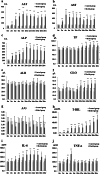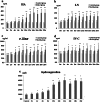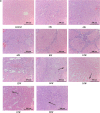Hepatic inflammation-fibrosis-cancer axis in the rat hepatocellular carcinoma induced by diethylnitrosamine
- PMID: 28238064
- PMCID: PMC11819159
- DOI: 10.1007/s00432-017-2364-z
Hepatic inflammation-fibrosis-cancer axis in the rat hepatocellular carcinoma induced by diethylnitrosamine
Abstract
Purpose: Hepatocellular carcinoma (HCC) cases are closely associated with chronic inflammation and fibrosis which is known as hepatic inflammation-fibrosis-cancer (IFC) axis. The aim of this study is to elucidate the development characteristics of the rat HCC model based on IFC axis.
Methods: The diethylnitrosamine (DEN)-induced rat HCC, which presents a stepwise histopathological progression that is similar to human HCC, was used to analyze the features of the different stages (inflammation, fibrosis, cancer). Rats were injected DEN at a dose of 30 mg/kg body weight twice a week for 11 weeks and the animals were observed until week 20. Time series sera and organ samples from the DEN animal model were collected to evaluate the dynamic changes.
Results: It was found that serum biochemical indicators (AST, ALT, ALP, TP, T-BIL, IL-6, TNF-α) from DEN-treated group were higher than that from control group. Fibrosis-related index in serum and live tissue were increased, respectively, from week 4 after DEN treatment. The expression of TGF-β1 and α-SMA in DEN-treated group was higher than that in control group. JAK2/STAT3 signaling was significantly up-regulated in DEN-treated group compared to that in control group. The histological examination confirmed that the hepatocarcinogenesis model was successfully established, and 100% of the animals in the DEN-exposed group developed liver tumors at 20 weeks. According to the pathological changes, the model characterized resulted in three stages: the inflammation stage (week 2-6), the fibrosis stage (week 8-12), and the HCC stage (week 14-20).
Conclusions: The results suggested that the HCC development was associated with IFC axis. The serial progression of hepatocarcinogenesis was according to the sequence of hepatic inflammation, fibrosis and then hepatic tumor.
Keywords: Hepatocellular carcinoma; Inflammation-fibrosis-cancer (IFC) axis; Liver fibrosis; Liver inflammation.
Conflict of interest statement
The author(s) declare(s) that they have no conflicts of interest to disclose.
Figures










Similar articles
-
Progression to fibrosis and hepatocellular carcinoma in DEN CCl4 liver mice, is associated with macrophage and striking regulatory T cells infiltration.Front Immunol. 2025 Jul 8;16:1601215. doi: 10.3389/fimmu.2025.1601215. eCollection 2025. Front Immunol. 2025. PMID: 40698077 Free PMC article.
-
Adefovir dipivoxil and pegylated interferon alfa-2a for the treatment of chronic hepatitis B: a systematic review and economic evaluation.Health Technol Assess. 2006 Aug;10(28):iii-iv, xi-xiv, 1-183. doi: 10.3310/hta10280. Health Technol Assess. 2006. PMID: 16904047
-
In vivo detection of metabolic changes by 1H-MRS in the DEN-induced hepatocellular carcinoma in Wistar rat.J Cancer Res Clin Oncol. 2005 Sep;131(9):597-602. doi: 10.1007/s00432-005-0684-x. Epub 2005 Oct 20. J Cancer Res Clin Oncol. 2005. PMID: 15991046 Free PMC article.
-
Transient elastography for diagnosis of stages of hepatic fibrosis and cirrhosis in people with alcoholic liver disease.Cochrane Database Syst Rev. 2015 Jan 22;1(1):CD010542. doi: 10.1002/14651858.CD010542.pub2. Cochrane Database Syst Rev. 2015. PMID: 25612182 Free PMC article.
-
FXR, MRP-1 and SLC7A5: New Targets for the Treatment of Hepatocellular Carcinoma.Technol Cancer Res Treat. 2024 Jan-Dec;23:15330338241276889. doi: 10.1177/15330338241276889. Technol Cancer Res Treat. 2024. PMID: 39194338 Free PMC article.
Cited by
-
Total C-21 Steroidal Glycosides From Baishouwu Ameliorate Hepatic and Renal Fibrosis by Regulating IL-1β/MyD88 Inflammation Signaling.Front Pharmacol. 2021 Oct 26;12:775730. doi: 10.3389/fphar.2021.775730. eCollection 2021. Front Pharmacol. 2021. PMID: 34764877 Free PMC article.
-
Annexins A2 and A5 are potential early biomarkers of hepatocarcinogenesis.Sci Rep. 2023 Apr 28;13(1):6948. doi: 10.1038/s41598-023-34117-8. Sci Rep. 2023. PMID: 37117324 Free PMC article.
-
Water-Soluble Pristine C60 Fullerene Inhibits Liver Alterations Associated with Hepatocellular Carcinoma in Rat.Pharmaceutics. 2020 Aug 22;12(9):794. doi: 10.3390/pharmaceutics12090794. Pharmaceutics. 2020. PMID: 32842595 Free PMC article.
-
Profiling Carbohydrate Metabolism in Liver and Hepatocellular Carcinoma with [13C]-Glycerate Probes.Anal Sens. 2021 Nov;1(4):196-202. doi: 10.1002/anse.202100034. Epub 2021 Sep 14. Anal Sens. 2021. PMID: 35693130 Free PMC article.
-
Suppressing growth and invasion of human hepatocellular carcinoma cells by celecoxib through inhibition of cyclooxygenase-2.Cancer Manag Res. 2019 Apr 9;11:2831-2848. doi: 10.2147/CMAR.S183376. eCollection 2019. Cancer Manag Res. 2019. PMID: 31114336 Free PMC article.
References
-
- Aravalli RN, Cressman EN, Steer CJ (2013) Cellular and molecular mechanisms of hepatocellular carcinoma: an update. Arch Toxicol 87:227–247. doi:10.1007/s00204-012-0931-2 - PubMed
-
- Bissell DM (2001) Chronic liver injury, TGF-β and cancer. Exp Mol Med 33:179–190 - PubMed
-
- Borbath I, Stärkel P (2011) Chemoprevention of hepatocellular carcinoma. Proof of concept in animal models. Acta Gastroenterol Belg 74:34–44 - PubMed
-
- Calès P, Boursier J, Chaigneau J et al (2010) Diagnosis of different liver fibrosis characteristics by blood tests in non-alcoholic fatty liver disease. Liver Int 30:1346–1354 - PubMed
-
- Costentin CE, Roudot-Thraval F, Zafrani ES et al (2011) Association of caffeine intake and histological features of chronic hepatitis C. J Hepatol 54:1123–1129 - PubMed
MeSH terms
Substances
LinkOut - more resources
Full Text Sources
Other Literature Sources
Medical
Miscellaneous

